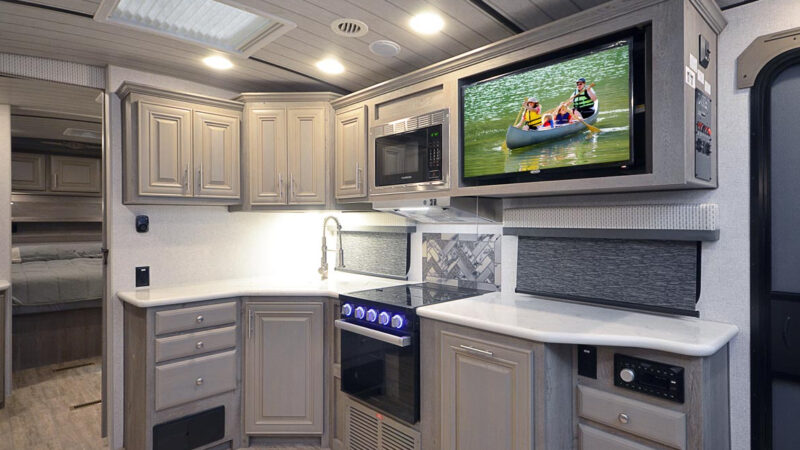What to Look for When Buying a Portable Power Station
If you’re in the market for a portable power station, there has never been a better time to go shopping. As battery technology and energy efficiency have improved, so have these rechargeable battery packs, making them a safer, quieter, and more environmentally friendly way to stay powered up at the campsite.
But sorting through all of the various brands and models currently available can be challenging. Not only are there dozens of options to choose from, the technical jargon used to describe their features can be confusing, too. Fortunately, most power stations have clearly defined specs that provide insight into their capabilities. Understanding those specs will help you choose the right one for you.
Here’s what you need to know before buying a portable power station of your own:
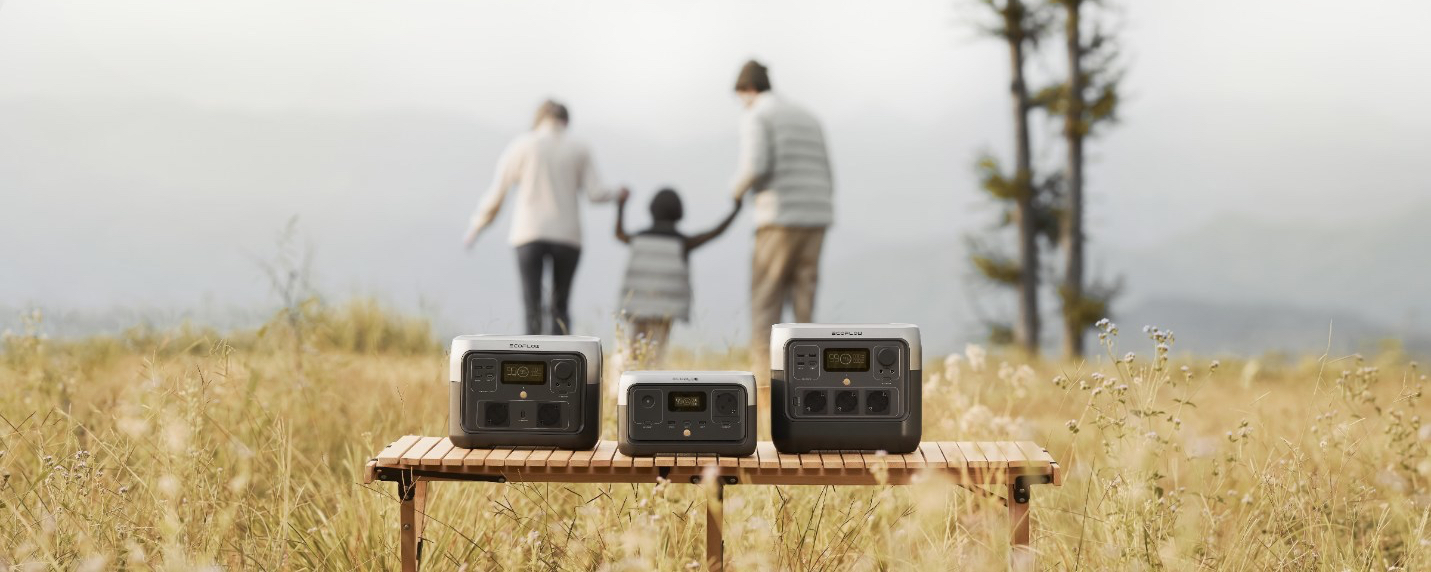
EcoFlow RIVER 2 Series Portable Power Stations
What is a Portable Power Station?
A portable power station is a device with a rechargeable battery pack that can store energy for use when and where traditional power options aren’t available. These gadgets range in size from small enough to easily carry in a backpack to so large they need built-in wheels to help haul them around. Usually, the larger the unit, the more energy it can store and produce, with some models capable of providing enough electricity to power a large RV or an entire house.
Portable power stations are equipped with an array of ports that allow owners to plug in small devices like smartphones, tablets, and laptops. Some produce enough power to run appliances such as coffee makers, portable refrigerators, and TVs. The largest models can serve as emergency backup power at home and replace shore power when boondocking.
Most power stations can be charged by plugging into a standard 120V AC wall outlet at home, a 12V DC port in a vehicle, or connecting solar panels in the field. This makes them more versatile than a gas-powered generator, although there are benefits and drawbacks to both types of power sources, which you can explore further here.
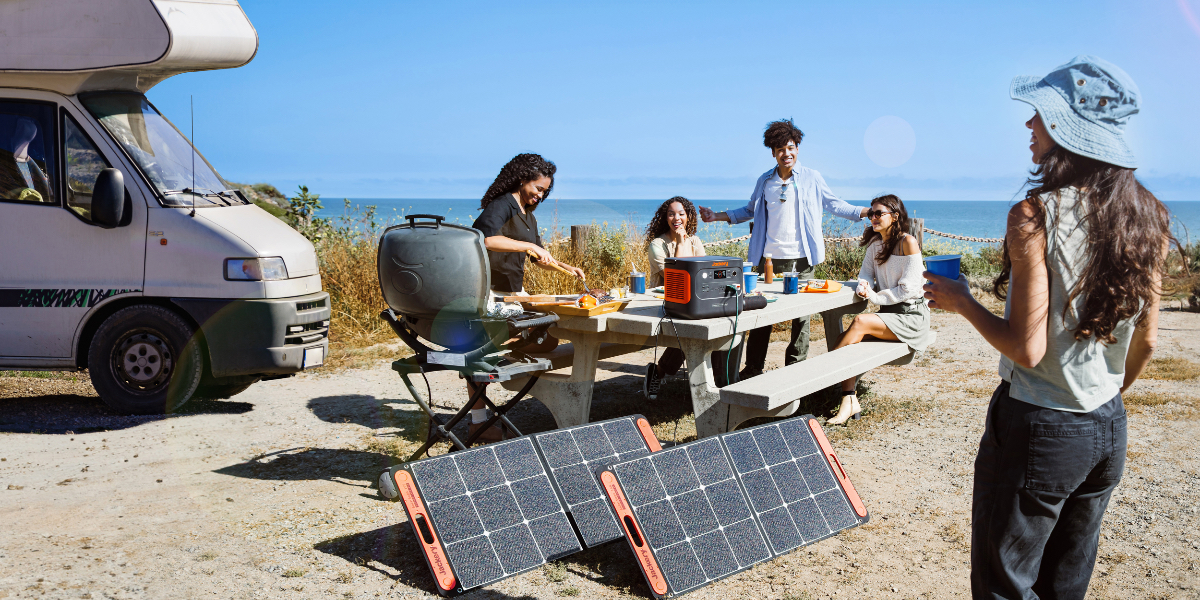
Photo Credit: Jackery
What to Consider When Buying a Portable Power Station
There are a number of variables to consider when determining which power station makes the most sense for you. The most important of those factors is knowing what devices and appliances you need to run and how long you’ll be away from a traditional power source.
As you would expect, smaller power stations are easier to carry but offer less capacity, while larger models provide more energy but are less portable. Finding the right balance to meet your needs is the key, which is why it is so essential to understand the technical specs of the models you’re shopping for.
These are the key factors to keep in mind:
Battery Capacity
The size of a battery is measured in watt hours (Wh) (or, in some cases, kilo-watt hours (kWh)), with higher numbers indicating more storage capacity. In the simplest terms, a 1,500Wh battery can run for up to 1,500 hours, provided it only puts out one watt of power. In reality, your gadgets and appliances will require much more energy than that, reducing battery life dramatically.
For reference, a smartphone requires about 5-10 watts to charge, while a microwave oven typically falls into the 800-1,000 watt range. Under those examples, a 1,500Wh power station could recharge a smartphone dozens of times but will only run a microwave for an hour or two before depleting its batteries.
Knowing how much power your devices require has a direct impact on the power station you choose. You’ll definitely want to select a model with plenty of capacity, or you could find yourself running out of electricity at an inopportune time. We generally recommend purchasing a unit that exceeds your expected needs so you always have some extra juice just in case you need it.
Power Output
Power output is also measured in watts and directly impacts the number and type of devices a power station can run. Higher output means multiple gadgets can be plugged in at the same time and allows the unit to supply enough energy to run appliances that require more juice. Air conditioners, space heaters, and blow dryers all require a lot of power to function properly and may not run at all if the power station can’t support the load.
Most power station manufacturers will list standard and peak power outputs for their devices. The standard level indicates how many watts the unit can deliver on a consistent basis, while the peak value shows the load it can temporarily handle when an appliance first starts up. For example, an air conditioner requires more energy when it turns on but will settle back to a more manageable level once it is running. But the power station needs to be able to handle that initial peak demand, or the appliance won’t run at all.
When purchasing a power station, you’ll need to understand how many watts are required by the appliances you plan to use. Make sure the device’s power output is enough to meet those needs, or you may not be able to make that hot cup of coffee in the morning or run your RV’s air conditioner during the heat of the day. You don’t have to worry about charging mobile devices, laptops, and other small electronics, as their power draw is generally very low. But any of the appliances mentioned above may put a strain on smaller power stations, preventing them from providing enough power to support all of the things you want to use while camping.
Power Input
As mentioned, most power stations can recharge by plugging them into a 120V AC wall socket at home, a 12V DC port in your vehicle, or solar panels while at the campground. Typically, the vehicle port will be the slowest way to charge, while a wall outlet will be the fastest. Charging times vary greatly but expect two to three hours when plugged in at home or eight to ten in a vehicle.
That said, some manufacturers have substantially upgraded how much power their units can receive while charging via solar panels. So much so that under optimal conditions, it is possible to charge faster using just the light from the sun. You’ll need several large solar panels to do that, which adds expense and reduces portability. But solar panels are a good way to keep a power station charged while traveling off-grid, providing free, clean energy on the go.
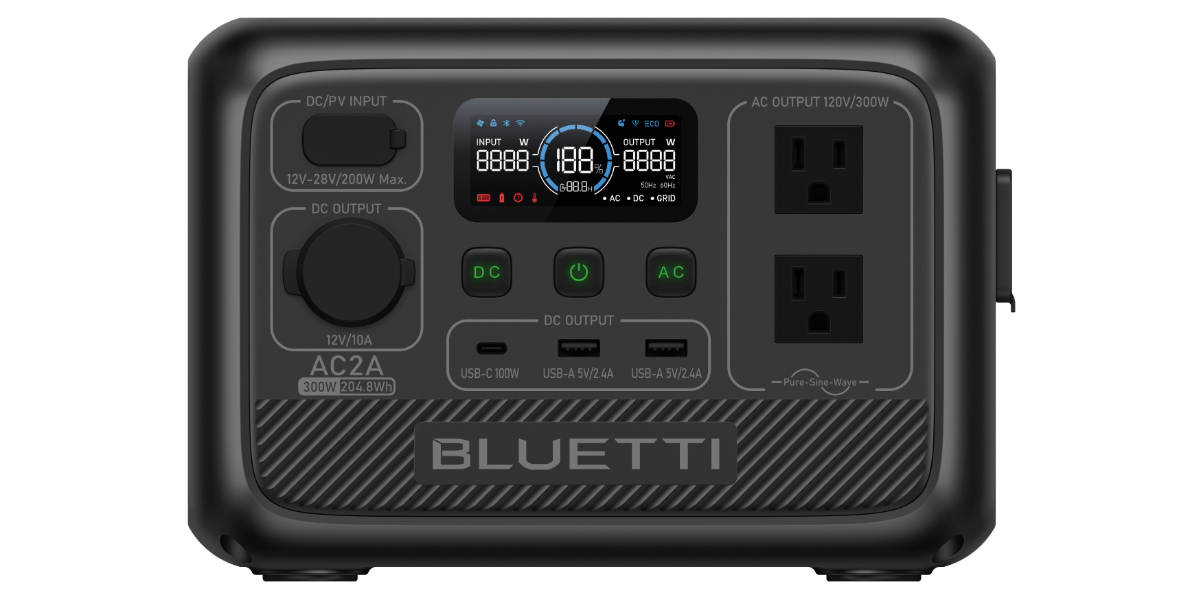
Photo Credit: Bluetti
Charging Ports
Most power stations come with at least one 120V AC port, although larger units can have as many as six or eight. A mix of USB-A and USB-C ports is pretty standard these days, with at least two of each quickly becoming the norm. Many models also include a 12V DC vehicle port and possibly one or two DC “barrel” ports, although those are becoming less common.
Depending on the size and configuration, a power station could have 15-20 charging ports in total, allowing an equal number of devices to plug in at any given time. The reality is, you’ll seldom need that many outlets as it is unlikely you’ll have so many gadgets charging simultaneously. Additional ports are always good, of course, but they require a larger battery capacity and power output to support the potential demand. This also leads to an overall larger power station in terms of both size and weight, as more space and components are required for the extra outlets.
Portability
Simply put, smaller power stations are easier to carry but provide less capacity and power output. Conversely, larger units offer more robust capabilities but are also bigger and heavier. Striking the right balance can be a challenge.
Essentially, the portability of a device comes down to how heavy it is and how far you have to carry it. If you’re parking your RV at a campsite and just need to move the power station outside the vehicle, weight and size aren’t all that important. But if you venture into the backcountry and want to bring a power source along with you, you’ll want something small and light.
Size and weight increase along with battery capacity and power output. A power station with a capacity of 300Wh and an output of 300W may weigh as little as six or seven pounds. Meanwhile, a device with a 3000Wh capacity and 3000W output may tip the scales at over 60 pounds. Striking the right balance for your needs may very well be found somewhere in the middle.
Battery Chemistry
Battery chemistry defines the type of batteries you’ll find inside a power station. In years past, most used lead acid batteries, which were heavy, less reliable, and had low storage density. Today, the majority of manufacturers have shifted to lithium-ion or lithium-iron phosphate (LiFePO4) power cells. These types of batteries are lighter, cost less to produce, and offer increased energy density. LiFePO4 batteries are also less flammable and have a longer lifespan, stretching out to eight to ten years of daily use.
Most of the major manufacturers now use LiFePO4 power cells, which levels the playing field in terms of reliability and performance. Lithium-ion batteries are a worthy alternative, although they don’t offer as much longevity of use. Avoid any power stations that still use lead acid battery chemistry, as those models are woefully outdated compared to current technology standards, making them less safe and efficient.
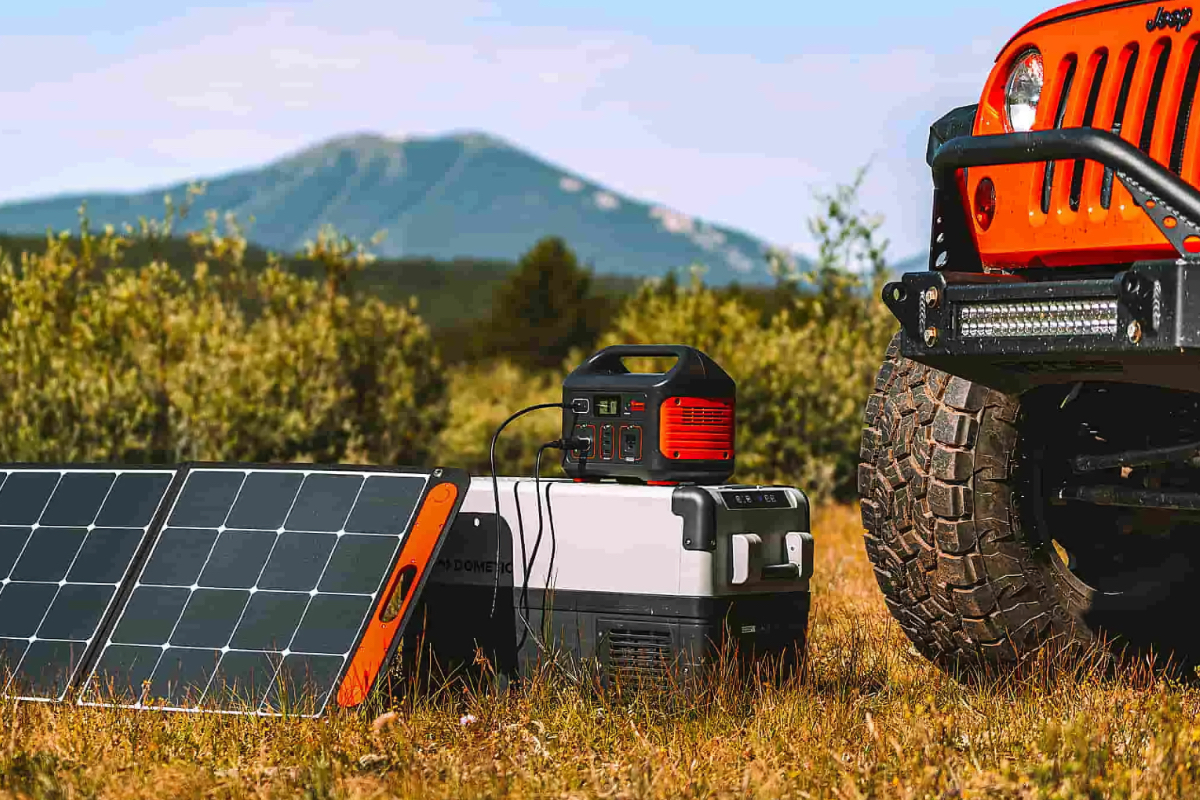
Image Courtesy of Jackery
Additional Features
Some portable power stations come with additional features that help differentiate them from the competition. For instance, many models offer remote monitoring and control via a smartphone app, allowing you to check battery charge levels, power in and out, and adjust settings over Bluetooth or Wi-Fi. This can be very handy around the campsite, even allowing you to activate or shut down the unit from inside your RV.
Other features to watch for include fast-charging capabilities that replenish the batteries at a significantly more rapid pace and the ability to serve as an uninterruptible power supply for mission-critical devices during an emergency power outage. Many power stations come with a built-in light for illuminating the campsite, while others offer a touchscreen for configuring settings. Some models even have replaceable battery packs for adding extra storage or to extend their use to other devices like portable refrigerators, electric tools, and recharging mobile devices on the go.
Whether or not any of these extra features are important to you will have an impact on which model you buy. That said, many of the top power station brands now include some or all of these features at no additional cost, giving consumers more value for their money.
Price
As the power station market has matured, there are now options available over a wide range of price points. Smaller units can be found for as little as $200, while larger, more capable models can cost as much as $6,000. This means there are devices to meet just about everyone’s needs and budget.
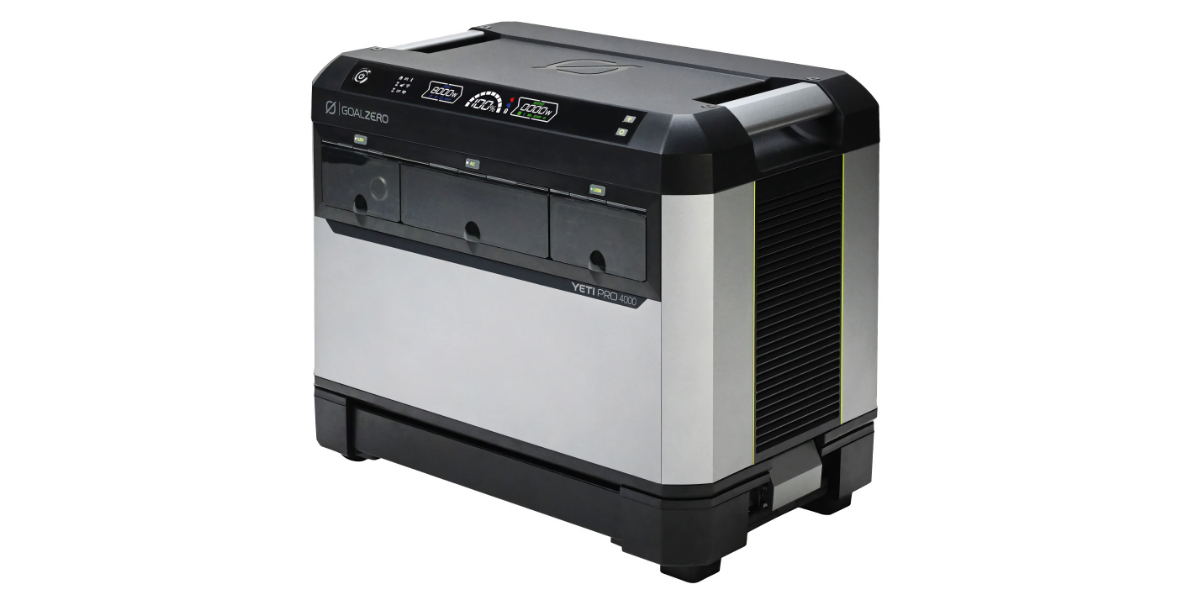
Photo Credit: Goal Zero
Top Brands
The good news for consumers is that more companies are making power stations than ever before. That increased competition leads to better devices, more features, and competitive pricing. By shopping around a bit, you’re sure to find a model that meets your needs at a price that suits your budget.
The top brands in the industry include Jackery, EcoFlow, Bluetti, Goal Zero, Geneverse, and Anker.
Conclusion
After defining the key specs and features for portable power stations, hopefully, you’re not better equipped to shop for one to meet your needs. Understanding battery capacity and power output helps make the purchasing process easier, but the other factors we mentioned are also important to keep in mind. Size and weight are two other factors to consider, especially if portability is important.
Camping World offers a number of small to mid-size power stations that cover a lot of RVer’s needs. For larger models or a broader selection, visit the brands mentioned above.
The post What to Look for When Buying a Portable Power Station appeared first on RV.com.
Source: https://www.rv.com/gear-accessories/what-to-look-for-when-buying-a-portable-power-station/



